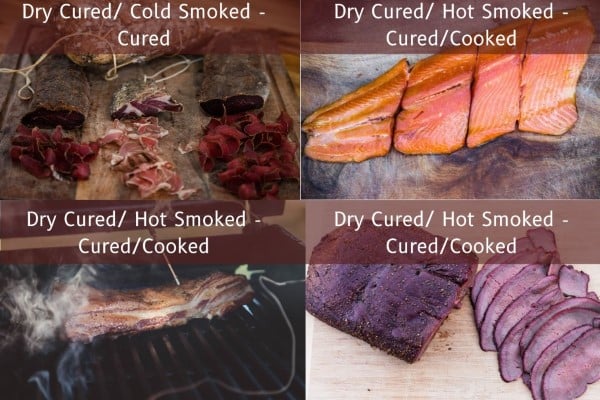Are you a barbecue enthusiast or a culinary adventurer looking to enhance your smoking game? If so, you’ve likely come across the terms “cold smoking” and “hot smoking.”
These two methods are more than just cooking techniques; they’re a doorway to unlocking flavors you’ve only dreamed of. Imagine serving your friends a platter of perfectly smoked salmon or a juicy brisket with that unmistakable smoky aroma, leaving them eager for more.
But before you dive into the world of smoking, it’s crucial to understand the differences between these methods. Doing so could elevate your next barbecue from ordinary to extraordinary. Ready to discover which technique will make your taste buds dance and turn your backyard into the talk of the town? Read on to find out.
Basics Of Smoking Techniques
Smoking is an ancient technique for preserving and enhancing flavors. It involves using smoke to cook or flavor food. There are two primary methods: cold smoking and hot smoking. Understanding these techniques opens up a world of delicious possibilities.
What Is Cold Smoking?
Cold smoking adds flavor without cooking the food. The temperature usually stays below 90°F. This method is ideal for cheese, fish, and cured meats. It requires a smoker and a separate heat source. The food absorbs the smoke flavor over time. Cold smoking is a slow process, often lasting several hours.
What Is Hot Smoking?
Hot smoking cooks the food as it flavors it. The temperature ranges from 165°F to 300°F. This method is perfect for meat, poultry, and fish. It combines cooking and smoking in one step. Hot smoking is faster, usually taking a few hours. The result is tender, flavorful dishes ready to eat.
Tools And Equipment
Cold smoking infuses food with flavor at low temperatures, while hot smoking cooks and flavors simultaneously. Each method requires specific tools, such as a smoke generator for cold smoking and a smoker grill for hot smoking. Understanding the differences helps in choosing the right equipment for desired results.
When you’re diving into the world of smoking, having the right tools and equipment can make all the difference in achieving that perfect flavor. Whether you’re leaning towards cold smoking or hot smoking, understanding the essentials will pave the way for success. Let’s explore what you need for each method and how these tools can transform your smoking experience.Essential Tools For Cold Smoking
Cold smoking requires a unique set of tools due to its low-temperature process. One key piece is a smoke generator. This device creates smoke without producing significant heat, crucial for cold smoking. A smoking chamber or box is equally important. It allows smoke to circulate around the food, infusing it with flavors without cooking. This can be as simple as a cardboard box or as elaborate as a specially designed cold smoking cabinet. Don’t forget thermometers. Monitoring the temperature ensures it stays under 90°F, preventing cooking and maintaining the cold smoking process. Have you ever tried cold smoking without these tools? The struggle of not achieving the desired flavor can be frustrating. It’s like baking without an oven—possible, but challenging and less effective.Essential Tools For Hot Smoking
Hot smoking is a different beast altogether. The primary tool you need is a smoker or grill that can maintain temperatures between 225°F and 300°F. This is essential for cooking and smoking simultaneously. Wood chips or pellets are your best friends here. They provide the smoke needed for flavor, and choosing the right type can elevate your dish. Imagine the difference between using hickory for a robust taste versus apple wood for a subtle sweetness. Lastly, a meat thermometer is indispensable. It ensures your food reaches the safe, desired temperature. There’s nothing worse than biting into a piece of undercooked meat after hours of anticipation. Have you considered how the choice of wood might change your dish? It’s like choosing spices for a recipe—each type adds its own unique touch. As you gather your tools, consider how each one impacts your smoking journey. Are you prepared to experiment with flavors and techniques? Your tools are the foundation. Make sure they’re solid and suited to your chosen smoking method.Temperature And Timing
Temperature and timing are crucial elements that determine the success of smoking meat. Whether you choose cold smoking or hot smoking, both methods require precise control to bring out the best flavors. Understanding these aspects can mean the difference between a perfectly smoked dish and a disappointing result.
Ideal Temperatures For Cold Smoking
Cold smoking is all about infusing flavor without cooking the food. The ideal temperature range is typically between 68°F and 86°F (20°C to 30°C). This low heat allows smoke to penetrate the food slowly, which is perfect for items like cheese, fish, and cured meats.
Maintaining this temperature can be challenging, especially in warmer climates. You might need to smoke early in the morning or during cooler months. Ever tried cold smoking salmon? The delicate smokiness achieved within this range is unmatched.
Ideal Temperatures For Hot Smoking
Hot smoking, on the other hand, cooks the food while smoking it. The temperatures range from 225°F to 275°F (107°C to 135°C). This method is ideal for meats like chicken, ribs, and brisket that benefit from being cooked through.
At these temperatures, the food cooks and absorbs smoke simultaneously. Have you ever tasted a brisket with a perfect smoke ring? That’s the result of maintaining consistent heat in this range.
Timing Considerations
Timing is just as important as temperature. Cold smoking can take several hours to several days, depending on the food and desired flavor intensity. Patience is key here. It’s not uncommon to cold smoke cheese over a weekend to allow the flavors to develop fully.
In contrast, hot smoking is quicker, with most dishes ready in a few hours. However, the type and cut of meat can drastically affect the timing. Have you ever wondered why pulled pork takes so long? The extended cooking time breaks down tough fibers, resulting in tender, juicy meat.
Have you experienced the anticipation of waiting for your smoked creation to be ready? The reward of perfectly smoked food is well worth the wait. What are your favorite foods to smoke? Share your experiences and tips below!

Credit: www.youtube.com
Flavor Profiles
Smoking is a popular method to infuse food with unique flavors. Understanding the flavor profiles of cold and hot smoking can elevate your culinary skills. Both methods offer distinct characteristics. Let’s explore these intriguing flavor profiles.
Flavor Characteristics Of Cold Smoking
Cold smoking imparts a subtle, delicate flavor. The process uses low temperatures, preserving the raw texture. Foods like cheese, nuts, and fish benefit from this technique. The smoky aroma enhances their natural flavors without overpowering. Cold smoking often requires longer times, allowing the smoke to gently permeate the food.
The result is a nuanced taste experience. A hint of smokiness lingers, complementing the food’s inherent flavors. Cold smoking is perfect for those who prefer a mild smoky touch.
Flavor Characteristics Of Hot Smoking
Hot smoking uses higher temperatures, resulting in bold flavors. The heat cooks the food, infusing it with a deep smoky taste. Meats, poultry, and some vegetables thrive under hot smoking. The process creates a rich, robust flavor profile.
This method delivers a pronounced smoky essence. The food gains a savory, complex taste that is full-bodied. Hot smoking is ideal for those who enjoy intense, smoky flavors.
Safety And Preservation
Cold smoking involves longer exposure to smoke at lower temperatures, preserving flavor while maintaining moisture. Hot smoking cooks food at higher temperatures, ensuring safety by killing bacteria, but altering texture and taste. Both techniques offer unique ways to enhance food preservation and flavor while maintaining safety.
When it comes to smoking food, both cold and hot smoking offer unique flavors and textures. But there’s more to consider than just taste. Safety and preservation are crucial aspects you need to understand. Whether you’re a seasoned smoker or a newbie, knowing how to keep your smoked foods safe and lasting longer is essential. Let’s dive into the practical safety tips and preservation techniques you need to know.Safety Tips For Cold Smoking
Cold smoking can enhance flavors without cooking the food. However, it comes with its own set of risks. Make sure the temperature stays below 90°F to prevent harmful bacteria from forming. Investing in a quality thermometer can help you monitor this. Brine your meats before smoking. This not only adds flavor but also acts as a barrier against bacteria. Always use fresh ingredients, as the smoking process doesn’t kill bacteria like cooking does. Ventilation is key. Ensure your smoking area is well-ventilated to avoid dangerous smoke buildup. You’ll want to enjoy your smoked salmon, not suffer from respiratory issues.Safety Tips For Hot Smoking
Hot smoking cooks and flavors food simultaneously, usually at temperatures between 225°F and 250°F. This method is generally safer as it kills bacteria, but vigilance is still important. Always preheat your smoker before adding food. Use a meat thermometer to confirm your food reaches the recommended internal temperature. This ensures that your meats are safe to eat. Regularly clean your smoker. Residue and grease can not only affect flavor but also pose a fire risk. A clean smoker leads to safer and tastier results.Preservation Techniques
Preservation is all about extending the life of your smoked goods. Vacuum sealing is an excellent option. It removes air, which slows down spoilage and keeps your smoked delights fresh longer. Consider curing meats with salt before smoking. This ancient method helps preserve the meat by drawing out moisture, making it less hospitable for bacteria. Refrigeration is your friend. Even after smoking, keep your foods in the fridge or freezer. This simple step can significantly extend their shelf life. Have you ever noticed how smoked foods seem to taste even better the next day? That’s preservation at work, enhancing flavors over time while keeping your food safe to enjoy. So, which smoking method suits your lifestyle better? Understanding these safety and preservation tips can help you make the best choice for your next smoking adventure.
Credit: eatcuredmeat.com
Popular Foods To Smoke
Smoking is an age-old method of preserving and flavoring food, and it remains incredibly popular today. Whether you prefer the gentle aroma of cold smoking or the intense flavors of hot smoking, knowing which foods to smoke can enhance your culinary skills. Let’s dive into the world of smoked foods and discover some of the best choices for each method.
Best Foods For Cold Smoking
Cold smoking is all about infusing flavor without cooking, making it perfect for delicate foods. Cheese is a classic choice, offering a smoky depth without melting. Imagine serving a platter of smoked cheddar at your next gathering; it’s a conversation starter!
Seafood lovers can rejoice with cold smoked salmon. Its silky texture and rich taste make it a brunch favorite. Pair it with bagels and cream cheese for an unforgettable meal.
For a unique twist, try smoking nuts. Almonds and pecans absorb the smoke beautifully, transforming into a savory snack that’s hard to resist. Why not experiment with different wood chips to find your perfect smoky flavor?
Best Foods For Hot Smoking
Hot smoking is perfect for foods that benefit from both cooking and smoking. Barbecue enthusiasts swear by smoked ribs. The combination of smoke and heat turns them into tender, mouth-watering delights.
Chicken is another favorite for hot smoking. With its versatility, you can try different marinades or rubs to suit your taste. Have you ever thought of smoking a whole chicken? It’s a showstopper at any feast.
If you’re a vegetarian, fear not. Vegetables like peppers and mushrooms take on a wonderful smokiness when hot smoked. They can be a fantastic addition to your grilled dishes or even served as a main course.
Have you considered smoking your favorite foods? It’s a fun way to experiment with flavors and textures. What’s your top pick for smoking?
Tips From The Experts
Smoking techniques, whether cold or hot, can transform your culinary creations into flavorful masterpieces. While both methods have their perks, understanding expert tips can be the difference between a smoky triumph and a culinary mishap. These insights can help you refine your smoking skills and achieve a perfect balance of flavor and texture. Let’s dive into some practical advice and see how you can avoid common mistakes while enhancing your smoked dishes.
Common Mistakes To Avoid
One common pitfall is using too much smoke. It might seem tempting to add extra wood chips for a deeper flavor, but excess smoke can lead to bitterness. Keep the smoke subtle and controlled for a pleasant taste.
Another mistake is neglecting temperature control. Hot smoking requires a consistent heat source, while cold smoking relies on cooler temperatures. Use a thermometer to monitor and maintain the correct heat level for each technique.
Don’t forget to prepare your meat properly. Whether brining or seasoning, ensure your meat is ready to absorb the smoky flavors. Skipping this step can result in bland results.
Enhancing Flavor And Texture
Choose your wood wisely. Different woods impart unique flavors; applewood offers a sweet note, while hickory brings a robust taste. Experiment with various wood types to find your favorite combination.
Consider marinating your meat before smoking. A simple marinade can enhance the depth of flavor and tenderize the meat, making it more succulent and delicious.
Keep an eye on the smoking time. Longer isn’t always better. Find the sweet spot where your meat is perfectly smoked and retains its juiciness and texture. Can you recall a dish where the smoking time made all the difference?
Remember, smoking is an art form that requires practice and patience. With these expert tips, you can elevate your smoking game and delight in the flavors you create. What new technique will you try next to surprise your taste buds?

Credit: www.facebook.com
Frequently Asked Questions
What Is Cold Smoking?
Cold smoking involves smoking food at temperatures below 90°F. It imparts flavor without cooking the food.
How Does Hot Smoking Work?
Hot smoking cooks food while smoking it. Temperatures range from 225°F to 275°F, adding both flavor and texture.
Which Foods Are Best For Cold Smoking?
Cheese, fish, and cured meats are ideal for cold smoking. They absorb flavors without cooking.
Is Hot Smoking Faster Than Cold Smoking?
Yes, hot smoking is quicker. It cooks and smokes food simultaneously, taking hours instead of days.
Can You Cold Smoke At Home?
Yes, you can cold smoke at home with the right equipment. Ensure proper ventilation and temperature control.
Conclusion
Choosing between cold smoking and hot smoking depends on your taste. Cold smoking offers rich, deep flavors without cooking the meat. Hot smoking cooks the meat while adding smoky flavors. Both methods bring unique experiences to the table. Consider the time you have and the flavor you want.
Cold smoking is slow and steady. Hot smoking is quicker and cooks through. Each method has its charm. Experiment and find what suits your palate best. Enjoy the art of smoking and create delicious meals that impress. Smoking is an adventure worth exploring.
Happy smoking!




